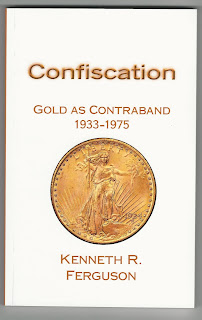Confiscation: Gold as Contraband 1933-1974 by Kenneth R. Ferguson was a pleasure to read. Ferguson writes well. I met Ken Ferguson in person at a coin show here in Austin. He speaks as intelligently as he writes. Our time together was enlightening.
Few people ever get past citing Executive Order 6102. Even when they do point to that document, they most often stop short of fully citing and discussing it. This book delivers the facts. Ferguson tells the whole story, going past 6102 to the subsequent orders and laws. He lays out carefully and logically the many relevant details that highlight this singular event. He also examines the public response. I was impressed with his explanations of how and why Britain, France, and Switzerland returned to striking gold coins after World War II, using dies from previous years.
As for whether surrendering gold was necessary, Ferguson demonstrates from several perspectives why it was not. Other nations made similar changes – demonetizing gold, going off the gold standard – without confiscating the private property of their citizens. That is a theme that Ferguson returns to often as he dissects the events and laws. If gold is money, then Congress (not the President) is authorized to define how much goes into what coins. That happened in 1834, for example. If gold is private property, then its uses as money are irrelevant in that context. Moreover, and most insightful (and damning) Ferguson shows that (1) Treasury stocks were not greatly improved by this law (though the Treasury did profit directly), and (2) the reason why is that half the gold in private holdings in the United States remained with its owners. People just ignored the law, as they had Prohibition earlier.
In 180 pages, this book provides a close and yet conversational examination of Franklin D. Roosevelt’s executive orders and the related Congressional acts that became laws. Ferguson identifies and explains the half dozen presidential orders and parallel banking acts, the criminalization of gold ownership, and the exclusions left open to numismatists. Turning to the international theater, the presentation builds on the official purposes of the Bretton Woods accords to illuminate the history of the 1950s and 1960s. It was that context which provided the impetus for President Gerald Ford to lift all of those restrictions in 1974.
From there, Ferguson considers the modern world, whether and to what extent gold is money, whether and to what extent it is an investment, and the prospects for a repeat of the draconian laws of the 1930s. That last is too often a springboard for ideologues who sell gold coins to harry the public into buying them. As a professional dealer in numismatic rarities, Ferguson shows more aplomb.
Ferguson earned his master’s degree from the Lyndon B. Johnson School of Public Affairs at the University of Texas at Austin. Since then, he was worked as a coin dealer. Those two facts explain why this book rests on careful research. His bibliography of 35 sources includes works by both John Kenneth Galbraith and Milton Friedman as well as authorities such as Q. David Bowers, John Craig, and Hans Schlumberger who are recognized within the numismatic community.
The weekend before, I attended a three-day seminar for authors on self-publishing. It was well worth the money. This book was published by the author and Ferguson did it right. The book is set in 11-point Garamond, which the user experience designers here in Austin assure me is the new standard in Roman (serif) fonts. Of course, it is perfect bound. Ferguson told me that he turned for help to a professional editor. From the seminar I attended the weekend before, I learned how much he paid for the ISBN. It makes a difference in the professional presentation of any work that claims authority. Confiscation: Gold as Contraband 1933-1974 by Kenneth R. Ferguson adheres to that standard.
PREVIOUSLY ON NECESSARY FACTS










